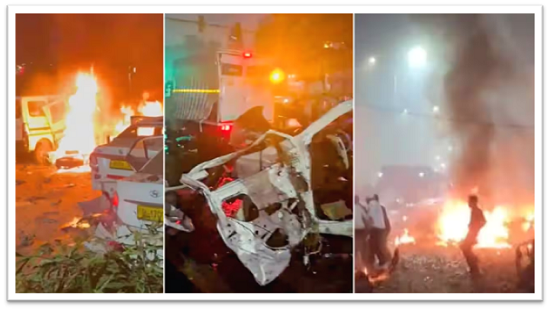
Red Fort Blast Triggers Nationwide Alert as Terror Network Linked to Medical Professionals Exposed in Faridabad and Pulwama
The quiet evening around Delhi’s Red Fort Metro Station turned into chaos when a vehicle explosion injured several pedestrians and damaged nearby vehicles on Monday evening. What initially appeared to be an isolated act of violence has now unravelled into a complex web of terror links spanning multiple states, involving medical professionals, chemical explosives, and suspected ties to proscribed outfits like Jaish-e-Mohammad and Ansar Ghazwatul Hind.
As security agencies tighten their grip, early investigations have exposed a chilling detail: individuals trained to save lives were allegedly using their expertise for destructive ends. The developments have placed the nation on high alert, forcing authorities to reevaluate the growing trend of radicalized professionals exploiting their technical knowledge for extremist agendas.
The Faridabad Link: Explosives and Arrests
The breakthrough came when police arrested Dr. Arif Ganai, whose interrogation led investigators to recover a staggering 358 kilograms of suspected ammonium nitrate from his rented accommodation in Faridabad’s Dhauj village. The chemical, commonly used in mining and construction, has been a recurring component in improvised explosive devices across past terror incidents in India, including Hyderabad (2013) and Pulwama (2019).
Soon after Ganai’s arrest, authorities apprehended another doctor, Dr. Adeel Majeed Rather from Qazigund in Jammu and Kashmir, for alleged links with the terror outfits Jaish-e-Mohammad and Ansar Ghazwatul Hind. The discovery of such connections within the medical fraternity has stunned investigators, who describe the case as an “unsettling intersection of intellect and extremism.”
Preliminary findings indicate that both men had been under surveillance for suspected online communication with known operatives based across the border. The recovery of chemicals, electronic devices, and encrypted documents from Ganai’s residence has given security agencies a crucial lead into what appears to be a coordinated module with multi-state reach.
Detentions from Pulwama and Expanding Network
Officials confirmed that at least five individuals have been detained from Pulwama for questioning, including Amir Rashid, believed to be the current owner of the vehicle used in the blast, his brother, and three others from nearby villages. Sources suggest that Rashid’s car was likely repurposed by the group to transport explosive materials under the guise of civilian movement.
A woman doctor from Lucknow has also been picked up for questioning regarding her alleged communications with the accused network. Police suspect that the module included at least four medical professionals, two of whom are now in custody, forming a core group responsible for both logistics and technical operations.
Investigators say that the arrests followed an ongoing inquiry into the sudden appearance of Jaish-linked posters on the outskirts of Srinagar last month. The propaganda material, which carried coded messages and recruitment slogans, hinted at a resurgence attempt by smaller cells of banned organizations operating covertly under local cover.
The Blast and Its Immediate Impact
The explosion occurred at approximately 6:52 p.m. on Monday when a slow-moving vehicle came to a halt at a red light near the Red Fort Metro Station. Eyewitnesses reported a loud bang followed by panic as smoke engulfed the area. Several pedestrians sustained injuries, and multiple vehicles were damaged in the impact.
Delhi Police swiftly cordoned off the area, deploying bomb disposal squads and forensic teams to collect samples for analysis. Preliminary reports suggest the use of ammonium nitrate-based explosives, consistent with the material found in Faridabad.
Authorities have registered a case under multiple stringent laws, including the Unlawful Activities (Prevention) Act (UAPA), the Explosives Act, and the Bharatiya Nyaya Sanhita. The combined charges indicate the gravity of the case, suggesting that investigators are treating the blast as part of a broader terror plot rather than an isolated attack.
Political and Administrative Response
Prime Minister Narendra Modi reviewed the situation in consultation with Union Home Minister Amit Shah, who confirmed that all possible leads were being explored. Shah assured that a multi-agency task force, including the National Investigation Agency (NIA) and the Intelligence Bureau (IB), was coordinating to uncover the full extent of the network.
“The situation is being monitored round the clock. No stone will be left unturned in ensuring that those behind this cowardly act are brought to justice,” Shah stated following a high-level security briefing.
The Home Ministry has called for an emergency meeting involving senior officials from Delhi Police, the National Security Guard (NSG), and state intelligence units to assess vulnerabilities in urban centers and strengthen preventive measures.
A Broader Warning: Radicalization in the Skilled Class
Security experts warn that the arrests signal a disturbing trend where educated professionals, especially those with specialized training in science or medicine, are being drawn into extremist ideologies. Their technical expertise in chemistry, anatomy, and logistics can be exploited to build sophisticated and lethal mechanisms, making them valuable recruits for terror outfits.
Former intelligence officials point out that the inclusion of professionals in such networks is not new but has gained momentum with the digital radicalization of recent years. Encrypted messaging apps, anonymous forums, and cross-border funding have enabled sleeper cells to communicate without detection.
A senior NIA officer remarked that the “professionalization of terror” poses a more insidious threat to national security, as it blends seamlessly into civil society, making detection harder and prevention more complex.
Nationwide Security Tightened
In the wake of the blast, security has been intensified across key metropolitan areas, including Delhi, Mumbai, and Hyderabad. Metro stations, airports, and public venues have been placed under heightened surveillance.
The Ministry of Home Affairs has directed all state police forces to maintain maximum alert and report any suspicious activity, particularly related to chemical storage and transport. Intelligence-sharing networks have also been activated to track cross-border movements and prevent further incidents.
Conclusion: Lessons from the Red Fort Blast
The Red Fort explosion and the subsequent arrests reveal more than just a terror plot, they highlight the growing sophistication of extremist recruitment and the vulnerabilities of an interconnected society. The use of educated professionals, especially doctors, underscores the urgent need for enhanced psychological profiling, digital monitoring, and inter-agency cooperation.
As the nation watches the investigation unfold, the case stands as a sobering reminder that terrorism today is no longer defined by borders or backgrounds. It thrives in hidden spaces, both physical and digital, and demands an equally intelligent, coordinated, and humane response from the state.
India’s challenge, therefore, is not just to catch the perpetrators but to dismantle the systems that allow knowledge to be weaponized against the very society it was meant to heal.





